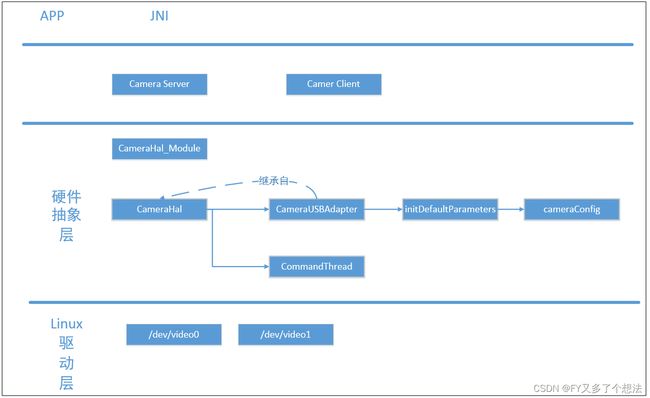Android9.0 系统摄像头前后置预览问题
1.Android 摄像头总体架构

在插入的USB摄像头后,会生成/dev/video0这样的设备节点,而在硬件抽象层中,会去判断是否存在该设备节点,以提供给android系统层使用,再往上分析就是android部分,暂时先不分析。
2.默认usb摄像头前后置预览
hardware/interfaces/目录下:
ANDROID_LENS_FACING_FRONT (前置); ANDROID_LENS_FACING_BACK (后置);
diff --git a/camera/device/3.4/default/ExternalCameraDevice.cpp b/camera/device/3.4/default/ExternalCameraDevice.cpp
index 3e346a21e..964c4ff5f 100644
--- a/camera/device/3.4/default/ExternalCameraDevice.cpp
+++ b/camera/device/3.4/default/ExternalCameraDevice.cpp
@@ -309,7 +309,7 @@ status_t ExternalCameraDevice::initDefaultCharsKeys(
UPDATE(ANDROID_LENS_INFO_AVAILABLE_OPTICAL_STABILIZATION,
&opticalStabilizationMode, 1);
- const uint8_t facing = ANDROID_LENS_FACING_BACK;
+ const uint8_t facing = ANDROID_LENS_FACING_FRONT;
UPDATE(ANDROID_LENS_FACING, &facing, 1);
// android.noiseReduction
3.设备同时接两个usb摄像头时,一个固定为前摄,一个固定为后摄
使用场景:客户在使用主板机器时会使用到两个usb摄像头,一个作为前置摄像头用于人脸识别,另一个作为后置摄像头;由于在安装时并不知道哪个端口的摄像头先插入,哪个后插入(设备节点中先接入的就会分配video0,而在android中一般定义video0为后置摄像头,video1为前置摄像头),就导致android系统层前后置摄像头混乱。
为了解决该问题,就需要在驱动中,将前后置摄像头和USB的硬件端口做一个绑定:
- 绑定usb端口号,从而绑定了固定的 /dev/video*:(目录:kernel/)
diff --git a/drivers/media/usb/uvc/uvc_driver.c b/drivers/media/usb/uvc/uvc_driver.c
index 435b2ee7a0f4..464f93e14a2f 100644
--- a/drivers/media/usb/uvc/uvc_driver.c
+++ b/drivers/media/usb/uvc/uvc_driver.c
@@ -1909,6 +1909,9 @@ int uvc_register_video_device(struct uvc_device *dev,
*/
video_set_drvdata(vdev, stream);
+ /*添加vdev->portnum = dev->udev->portnum, 这里先将USB的portnum存下来,在创建设备节点的是否,就 会根据该变量来区分硬件的上哪个USB是前置,哪个USB是后置*/
+ vdev->hw_portnum = dev->udev->hw_portnum;
+ printk("vdev->hw_portnum=%d\n",vdev->hw_portnum);
ret = video_register_device(vdev, VFL_TYPE_GRABBER, -1);
if (ret < 0) {
uvc_printk(KERN_ERR, "Failed to register %s device (%d).\n",
diff --git a/drivers/media/v4l2-core/v4l2-dev.c b/drivers/media/v4l2-core/v4l2-dev.c
index 72a8b8047bd0..e1a28ea90e37 100644
--- a/drivers/media/v4l2-core/v4l2-dev.c
+++ b/drivers/media/v4l2-core/v4l2-dev.c
@@ -849,6 +849,16 @@ int __video_register_device(struct video_device *vdev, int type, int nr,
/* Pick a device node number */
mutex_lock(&videodev_lock);
+ /*这里的“7 == vdev->portnum”是根据时机板子的端口上的,在调试的时候,可以先将portnum变量的值打印出来,就知道如何区分了*/
+ printk("dxq portnum=%d\n",vdev->hw_portnum);
+ if(vdev->vfl_type == VFL_TYPE_GRABBER) {
+ if(7 == vdev->hw_portnum) {
+ nr = 7;
+ }else if(8 == vdev->hw_portnum) {
+ nr = 8;
+ }
+ }
+
nr = devnode_find(vdev, nr == -1 ? 0 : nr, minor_cnt);
if (nr == minor_cnt)
nr = devnode_find(vdev, 0, minor_cnt);
diff --git a/drivers/usb/core/hub.c b/drivers/usb/core/hub.c
index 1e5f55118d42..02d85ea9488d 100644
--- a/drivers/usb/core/hub.c
+++ b/drivers/usb/core/hub.c
@@ -2167,6 +2167,15 @@ static void show_string(struct usb_device *udev, char *id, char *string)
static void announce_device(struct usb_device *udev)
{
+ udev->hw_portnum=0;
+ //printk("kobject_name(&udev->dev->kobj)=%s\n",kobject_name(&(udev->dev.kobj)));
+ if(!strcmp("2-1.1.1",kobject_name(&(udev->dev.kobj)))){
+ udev->hw_portnum=7;
+ }else if(!strcmp("2-1.1.2",kobject_name(&(udev->dev.kobj)))){
+ udev->hw_portnum=8;
+ }
+ //printk("udev->hw_portnum=%d\n",udev->hw_portnum);
+
dev_info(&udev->dev, "New USB device found, idVendor=%04x, idProduct=%04x\n",
le16_to_cpu(udev->descriptor.idVendor),
le16_to_cpu(udev->descriptor.idProduct));
diff --git a/include/linux/usb.h b/include/linux/usb.h
index 5c03ebc6dfa0..05896dae09c5 100644
--- a/include/linux/usb.h
+++ b/include/linux/usb.h
@@ -572,6 +572,7 @@ struct usb_device {
unsigned short bus_mA;
u8 portnum;
+ u8 hw_portnum;
u8 level;
unsigned can_submit:1;
diff --git a/include/media/v4l2-dev.h b/include/media/v4l2-dev.h
index 5a562ad58bb9..f74fbcaf0ba2 100644
--- a/include/media/v4l2-dev.h
+++ b/include/media/v4l2-dev.h
@@ -128,6 +128,7 @@ struct video_device
/* Internal device debug flags, not for use by drivers */
int dev_debug;
+ int hw_portnum; /*usb hw port*/
/* Video standard vars */
v4l2_std_id tvnorms; /* Supported tv norms */
- hal层通过/dev/video* 做判断:(目录:hardware/interfaces/camera/)
diff --git a/camera/device/3.4/default/ExternalCameraDevice.cpp b/camera/device/3.4/default/ExternalCameraDevice.cpp
index 9382c511b..9d246c36a 100644
--- a/camera/device/3.4/default/ExternalCameraDevice.cpp
+++ b/camera/device/3.4/default/ExternalCameraDevice.cpp
@@ -21,6 +21,7 @@
#include